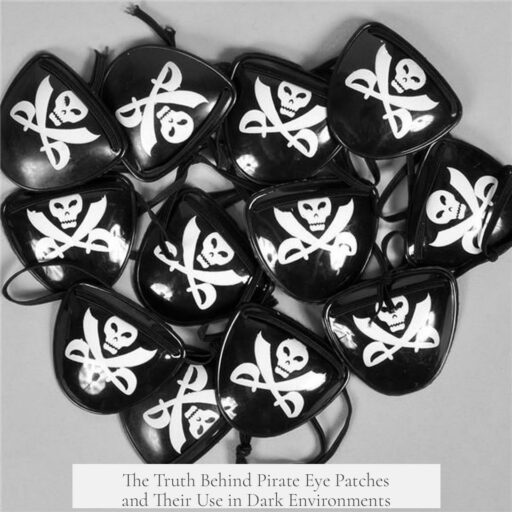Pirate eye patches are largely a myth rooted in popular culture rather than historical fact, and the idea that pirates wore patches to keep one eye adjusted to darkness when moving below deck is not supported by historical evidence.
The widespread belief is that pirates donned eye patches to preserve night vision for below-deck combat or stealth. However, research shows that very few pirates actually wore eye patches. When they did, it was typically because they had lost an eye in battle or to disease. Eye patches functioned much like any other individual using one to cover an injury. There is no credible documentation or firsthand accounts suggesting that pirates used patches to adapt their vision to darkness before moving below deck.
Moreover, the idea that pirates frequently fought below decks does not align with historical naval practice. Pirate attacks usually took place on the main deck where there was space for combatants to maneuver and use weapons effectively. Below decks on most ships were cramped, occupied by cargo, or simply unsuitable for fighting. Additionally, the lower decks were not completely dark during the day, as hatches and gun ports provided natural light. The exigencies of combat and ship control made it unlikely that pirates would retreat below deck during boarding actions.
Scientific testing, such as that performed by Mythbusters, indicates that covering one eye can help maintain night vision in that eye. However, this does not confirm that pirates adopted this strategy. If preserving night vision was critically useful, it stands to reason that naval or military sailors, as well as pirates, would have implemented eye patches regularly. Historical records show no such widespread usage.
When exploring historical figures, though some pirates are known to have lost an eye, none are conclusively documented to have worn eye patches. For example:
- Tee Wetherly, a crew member from 1699 who lost an eye;
- Captain Samuel Burgess, who was blind in one eye due to disease;
- Captain Philip Lyne, who lost an eye in battle;
- Rahmah ibn Jabir al-Jalahimah, an early 1800s pirate from the Persian Gulf, noted for losing an eye but not confirmed to have worn an eye patch.
These accounts do not mention eye patches, casting further doubt on the prevalence of the trope. Even Rahmah ibn Jabir, sometimes cited as a pirate with an eye patch, has no solid evidence of wearing one.
The pirate eye patch as an iconic visual element mainly comes from American media of the early 20th century. The first significant appearances trace back to film and animation:
- “Treasure Island” (1920), where John Silver is depicted with an eye patch;
- “The Buccaneers,” a 1924 Our Gang short;
- “Shanghaied” (1934), a Mickey Mouse cartoon featuring an entire crew of eyepatch-wearing villains.
This trope gained momentum in American pop culture well before it appeared in literature, such as the 1967 novel “Chosen” by Chaim Potok. A Canadian doctor’s 1934 paper theorized the “pirate’s patch” for night vision adaptation, but this idea was speculative and born from existing film imagery rather than historical accounts.
Thus, the pirate eye patch motif seems to be a theatrical invention, possibly emerging from American stage revues like the Ziegfeld Follies. It was embraced by media as an instantly recognizable symbol of piracy and roguishness.
Despite the myth, some argue there may be practical reasons for wearing an eye patch at sea. Covering one eye before moving between bright and dark environments could indeed help preserve night vision in that eye. Experienced sailors might have trained themselves to compensate for any changes in depth perception caused by using one eye. Yet, this explanation remains speculative without historical proof that pirates followed such practice.
In summary, evidence rejects the notion that pirate eye patches served primarily to aid dark adaptation. The trope results from modern media rather than genuine maritime strategy. Eye patches related to actual eye injuries, and their popular image predates widespread use in film and theatre.
| Aspect | Fact |
|---|---|
| Historical Usage | Few pirates wore eye patches; mostly for covering injuries |
| Pirate Boarding Combat | Fought mainly on main decks; below decks unsuitable and not fully dark |
| Dark Adaptation Theory | Not supported by historical evidence, largely a speculative myth |
| Origin of Trope | Early 20th-century American films and theatre popularized eyepatches |
| Notable Pirates | Lack documented eyepatch use despite some losing eyes |
- Pirate eye patches are primarily used to cover lost or injured eyes, not for vision adaptation.
- Combat generally occurred on main decks where lighting conditions didn’t require special dark adaptation.
- The eye patch pirate stereotype emerged from 20th-century American media, not historical practice.
- No strong historical evidence supports eye patches improving night vision for pirates.
- Practical use of eye patches for night vision is plausible but unproven in maritime context.
Why is the idea that pirates wore eye patches to keep one eye adjusted to darkness likely false?
There is no historical evidence supporting this idea. Pirates rarely wore eye patches, mostly to cover injured or lost eyes. Also, pirate battles mostly happened above deck where lighting was sufficient.
Did historical pirates actually wear eye patches?
No attested examples exist of pirates using eye patches. Some lost eyes in battles, but sources never mention wearing patches. This detail appears mainly in modern fiction and media.
Where did the pirate eye patch image originate from?
The trope comes from early 20th-century American films and popular culture. Films like “Treasure Island” (1920) helped popularize the stereotype, not historical accounts.
Is there a scientific basis for wearing an eye patch to preserve night vision?
Wearing a patch can keep one eye adapted to low light. However, this practice was not documented among pirates and seems unlikely given their fighting conditions.
Why wouldn’t pirates benefit from adapting one eye to darkness?
Pirate combat mostly occurred on well-lit decks. Below deck areas were cramped and poorly suited for fighting. Thus, adapting an eye to darkness didn’t provide much tactical advantage.
Are eye patches common among sailors or military personnel for night vision?
No evidence supports the use of eye patches for night vision among sailors or military groups. If practical, it would likely have been adopted beyond pirates, but it was not.




